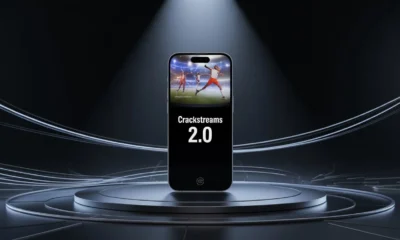Technology
Why is Hyper Personalization Important in App Localization?

People from all over the world might use your mobile application. However, not everyone shops, speaks, or even scrolls in the same way. For this reason, today’s app developers concentrate on hyper personalization.
It all begins with clear communication. That’s why many developers partner with experts in software translation services to make sure every word, button, and message fits the person reading it. When an app speaks like its user, it feels more useful. And that makes users want to stay.
What Is Hyper Personalization?
Hyper personalization is when apps don’t just show translated text, they adapt to each person’s habits, language, and location. It’s more than using a name in a message. It’s about giving users a full experience that feels like it was made for them.
Hyper personalization delivers both, automatically. It’s not about more features. It’s about making features feel right for each person.
Why It Helps Users Feel At Home
An app is like a digital space. When users open it, they step into your world. But if that world feels cold, confusing, or foreign, they’ll leave. Hyper personalization makes your app feel familiar. It matches the words, colors, offers, and even images to what the user expects.
This comfort helps build trust. And when people trust your app, they use it more. They return more. They even recommend it.
Better Engagement Through Familiar Content
Let’s say two users open the same app: one in Italy and one in South Korea. If both see the same welcome screen, it might work, but it won’t feel special. But if the screen says “Ciao Marco!” in Italy and “안녕하세요, Ji-Hyun!” in South Korea, it feels warm. The app speaks their language. It knows them.
How Local Culture Changes App Behavior
Culture shapes how people use apps. Some users like to scroll quickly. Others tap slowly and read more. Some want lots of options. Others prefer a simple screen. Hyper personalization helps adjust the app’s feel based on user habits and cultural norms. This makes the app easier to use, and more fun too.
Even color choices matter. Red may mean “good luck” in one place and “danger” in another. Personalizing these details shows that your brand pays attention.
Push Notifications That Actually Work
Many apps send push alerts. But if the alerts feel off or random, people turn them off, or delete the app. With hyper personalization, these messages are tailored. They show offers, tips, or reminders based on what the user has done or where they live.
For example, a winter jacket sale in Canada makes sense in December, but not in Australia. The app knows this, so it sends the right message to the right person. That’s how smart apps build smart engagement.
Languages Can’t Just Be Translated – They Must Be Adapted
A direct word-for-word translation is often not enough. One phrase may sound friendly in one country but rude in another. Hyper personalization uses more than just translated words. It checks the tone, sentence length, and context too.
Apps that do this well are not only clear, they are likable. They feel local, even when built far away.
App Onboarding Gets Smarter
When users first download your app, they need to understand how it works. A simple onboarding process helps. Hyper personalization makes onboarding faster by showing only what matters. It uses the user’s language, preferred currency, and region to guide them through the app. This saves time. It also makes the user feel respected from the very first tap.
Helps You Compete in Local App Markets
Many app stores have apps made for local users. These apps often win over global apps because they feel more “local.” Hyper personalization gives you a fighting chance. It lets your global app act like a local one.
If your app understands users in Turkey, Thailand, or Tunisia better than a local app does, people will choose yours. That’s how personalization creates an edge.
Real-Time Changes Based on Use
Some apps now change as users use them. If someone always buys sports gear, the homepage may start showing gym shoes and water bottles.
Hyper personalization makes this possible. It learns from the user’s actions, then adjusts the app layout or offers in real time. This creates a smart app experience that grows with the user.
Boosting Revenue Without Adding Features
You don’t always need to build new tools. Sometimes, better personalization increases earnings by making the same tools work smarter. An offer shown to the right user, at the right time, in the right language, is more likely to be used. That means higher conversion and higher revenue.
This is where android app localization services come in. They help tailor the mobile experience for Android users in different countries, ensuring your message fits every screen, style, and speech pattern.
Why Personalization Lowers Uninstalls?
Apps are deleted quickly if they don’t “click” with the user. That first day is important. When the app feels wrong, maybe the language is stiff or the content feels off, people close it. But when it feels like it was made for them, they explore more. Hyper personalization helps apps pass this first test. And that’s how you keep users longer.
Letting Experts Handle the Personal Touch
Hyper personalization is not something you should do alone. It’s detailed. It needs care. Working with the right team makes all the difference. Many companies rely on professional teams to make their app language feel smooth, friendly, and correct.
Experts know what works and what doesn’t. They help your app talk like a local, without sounding fake. This saves you time, protects your brand, and keeps your users happy.
Final Words
People don’t want apps that feel foreign. They want apps that speak their language, match their habits, and understand their needs. Hyper personalization is not just a “nice to have.” It’s now expected. When your app feels like it was made for one person, that person keeps it. That’s how your app grows, one happy user at a time.
Technology
Boeing 787: Revolutionizing Air Travel with Cutting-Edge Technology

The skies have changed dramatically with the introduction of the Boeing 787 Dreamliner. This aircraft is not just another addition to the fleet; it represents a leap into a new era of air travel. With its sleek design and advanced technology, the 787 has transformed how airlines operate—and how passengers experience flying.
Imagine stepping onto an airplane that prioritizes your comfort while also being environmentally friendly. The Boeing 787 does just that, boasting features that cater to both travelers and airline operators alike. As we delve deeper into this marvel of aviation engineering, you’ll discover what makes the Dreamliner stand out in an ever-evolving industry where innovation reigns supreme. Get ready to explore how the Boeing 787 is reshaping air travel as we know it!
The Innovative Features of the Dreamliner:
The Boeing 787 Dreamliner is a game-changer in the aviation world. Its advanced aerodynamics and lightweight materials set it apart from previous models. Made primarily of carbon-fiber-reinforced polymer, the aircraft reduces weight significantly without compromising strength.
Fuel efficiency is another standout feature. The 787 boasts up to 20% less fuel consumption compared to similar-sized airplanes. This not only lowers operating costs for airlines but also contributes to reduced carbon emissions, making it an environmentally friendly choice.
Passenger comfort has seen remarkable enhancements as well. Larger windows with electronic tinting allow more natural light inside the cabin, creating a more pleasant atmosphere. Improved air quality and lower cabin altitude levels contribute further to a better flying experience, helping travelers feel fresher upon arrival.
Each of these innovations reflects Boeing’s commitment to pushing boundaries and redefining what modern air travel can be.
A. Advanced aerodynamics and lightweight materials
The Boeing 787 Dreamliner stands out due to its advanced aerodynamics. Its sleek design minimizes drag, allowing for smoother flights. This innovation translates into improved fuel efficiency and reduced operational costs.
Another key feature is the use of lightweight materials. The fuselage comprises carbon-fiber-reinforced polymer, which significantly reduces weight compared to traditional aluminum structures. Lighter planes consume less fuel, benefiting both airlines and passengers alike.
These advancements are not just technological feats; they represent a shift in how aircraft are constructed. With improved aerodynamic shapes and robust yet light materials, the 787 sets a new standard for modern aviation design.
As airlines seek to enhance performance while being environmentally conscious, the combination of these elements positions the Boeing 787 as a leader in sustainable air travel solutions. The impact on future aircraft designs will surely be profound.
B. Fuel efficiency and sustainability
The Boeing 787 Dreamliner stands out for its remarkable fuel efficiency. Designed with next-generation engines, it consumes significantly less fuel compared to older aircraft models. This reduction not only cuts operational costs but also minimizes the environmental footprint.
Sustainability is at the core of its design philosophy. The use of advanced composite materials helps reduce weight, further enhancing fuel economy. Each flight emits fewer greenhouse gases, making air travel greener.
Moreover, airlines operating the 787 benefit from lower maintenance needs and extended range capabilities. These features allow carriers to fly longer distances without compromising on performance or comfort.
As global awareness around climate change grows, innovations in aviation technology like those seen in the 787 become increasingly vital. With enhanced sustainability measures in place, this aircraft sets a new standard for eco-friendly air travel.
C. Comfort and passenger experience enhancements
The Boeing 787 Dreamliner prioritizes passenger comfort like never before. Its spacious cabin design creates a sense of openness, allowing travelers to stretch out and relax during long flights.
Large windows enhance the experience by providing breathtaking views while also featuring adjustable dimming capabilities. This means passengers can control the amount of light entering their space, reducing glare and creating a more serene atmosphere.
Moreover, improved cabin pressurization at lower altitudes helps reduce fatigue. The humidity levels are higher than on traditional aircraft, alleviating dryness often associated with air travel.
Additionally, innovative lighting options mimic natural daylight cycles. This promotes better sleep patterns and overall well-being throughout the journey.
With quieter engines contributing to a peaceful environment, flying in the Boeing 787 becomes not just transportation but an enjoyable experience for all onboard.
Impact on Airline Industry and Travel Experience
The Boeing 787 has significantly reshaped the airline industry. Its advanced technology allows airlines to operate more efficiently, reducing operational costs and enabling longer routes without needing refueling stops.
Passengers benefit immensely from these innovations. Many report a smoother ride due to improved aerodynamics, which minimizes turbulence effects.
Cabin pressure adjustments enhance comfort levels for travelers, making long-haul flights less exhausting. The larger windows and better lighting create an inviting atmosphere that passengers appreciate.
Airlines have started marketing their fleets with the Dreamliner as a premium experience option. This shift has encouraged competition among carriers to offer enhanced services and amenities on board.
Sustainability is also at the forefront of many airlines’ strategies now as they seek to attract eco-conscious travelers while meeting regulatory pressures regarding emissions reductions. The Boeing 787 sets a new standard in this arena, prompting others in the industry to follow suit.
Challenges Faced During Development
The development of the Boeing 787 Dreamliner was not without its hurdles. One significant challenge arose from its innovative materials. The extensive use of carbon-fiber-reinforced polymer required new manufacturing techniques, which led to delays.
Supply chain issues also played a critical role in the project’s timeline. The global nature of sourcing parts meant that various components sometimes arrived late or did not meet stringent quality standards. This complicated coordination among teams across different continents.
Additionally, ensuring safety and regulatory compliance was paramount. With so many advanced technologies integrated into one aircraft, engineers faced rigorous testing protocols before receiving approval for commercial flights.
These obstacles tested Boeing’s resilience but ultimately pushed them toward innovation and improvement in their processes.
Future of the Boeing 787 Dreamliner
The future of the Boeing 787 Dreamliner looks promising as it continues to evolve with technological advancements. Airlines are increasingly focused on sustainability, and the Dreamliner is well-positioned to lead in this area.
Boeing aims to enhance fuel efficiency even further. Innovations in engine technology could reduce emissions and operational costs, making air travel more sustainable.
Passenger experience will also see improvements. Enhanced cabin designs may offer a more tranquil flying environment, reducing noise levels while improving air quality.
As airlines adapt to changing market demands, flexibility becomes crucial. The versatility of the 787 allows carriers to optimize routes efficiently without compromising comfort or performance.
With increasing global connectivity needs, the Boeing 787 will likely play a vital role in shaping how we approach long-haul travel into the coming decades.
Other Revolutionary Aircrafts in Development
The aerospace industry is buzzing with innovation. Numerous companies are hard at work on revolutionary aircraft that promise to reshape air travel.
One notable project is the Airbus A220, designed for short-haul routes. Its advanced materials and aerodynamic design enhance efficiency while providing a comfortable experience for passengers.
Electric propulsion systems are also gaining traction. Companies like Zunum Aero aim to develop hybrid-electric planes, significantly reducing carbon emissions and operational costs.
Another exciting venture is supersonic travel. Boom Supersonic’s Overture aims to cut flying time in half without sacrificing passenger comfort or safety. This could revive the golden age of aviation where speed was paramount.
Urban air mobility solutions are emerging rapidly, with startups creating electric vertical takeoff and landing (eVTOL) aircraft for city commuting. These innovations might transform how we view daily transportation in congested metropolitan areas.
Conclusion
The Boeing 787 Dreamliner stands as a testament to innovation in the aviation industry. With its advanced aerodynamics, lightweight materials, and cutting-edge technology, it has set new benchmarks for fuel efficiency and passenger comfort.
As airlines continue to embrace this revolutionary aircraft, travelers can expect an enhanced flying experience characterized by quieter cabins and improved air quality. The impact of the 787 on the airline industry cannot be understated; it has inspired competitors to rethink their designs and operational strategies.
Despite facing challenges during development, such as manufacturing delays and technical issues, Boeing’s commitment to excellence ensured that these hurdles were overcome. The future of the Boeing 787 looks promising with ongoing improvements being made in response to feedback from both airlines and passengers.
As we look ahead, several other groundbreaking aircraft are also in development. These innovations will further reshape air travel as we know it today. With each advancement, aviation continues its journey into a more sustainable and enjoyable future for everyone involved.
Technology
Discover the Next Generation of AI Editing with FaceSwapAI

Artificial Intelligence (AI) has changed the creative world forever — from enhancing photos to generating entire works of digital art. Now, AI has taken another incredible leap forward with face swapping technology. Whether for fun, entertainment, or professional use, FaceSwapAI is redefining how we create and edit visual content. With advanced deep learning algorithms and an intuitive design, it’s the best face swap ai platform available today — simple, smart, and amazingly powerful.
What Is FaceSwapAI?
FaceSwapAI is an innovative online platform that allows users to swap faces in photos and videos instantly. Using advanced AI and machine learning, it recognizes facial features, lighting, and expressions to create smooth, realistic results. What once required hours of manual editing in complex software can now be done automatically in seconds — all through your web browser.
Whether you want to put your face on a famous movie character, swap faces with a friend, or create viral social media content, FaceSwapAI makes it effortless. The platform is designed for everyone — from casual users who want to have fun to professionals who need powerful creative tools.
Why FaceSwapAI Is the Best Face Swap AI
In a growing sea of AI tools, FaceSwapAI stands out for its precision, speed, and ease of use. Here’s why it’s considered the best face swap ai available today:
- Unmatched Realism: FaceSwapAI produces seamless, lifelike results that perfectly match lighting, angles, and skin tones.
- Fast and Easy: Create a perfect face swap in seconds with no editing experience needed.
- Completely Online: No downloads or installations — use it directly from your browser on any device.
- Free and Accessible: Enjoy free AI face swapping with professional-level results.
- Safe and Ethical: FaceSwapAI ensures data privacy and encourages positive, responsible use of its technology.
With this combination of performance, accessibility, and trust, it’s no wonder FaceSwapAI has become a favorite among creators, influencers, and everyday users.
Next-Level Creativity in Seconds
FaceSwapAI empowers you to explore your imagination like never before. You can:
- Create hilarious memes and viral social media videos.
- Experiment with movie and celebrity face swaps.
- Make creative projects for school, marketing, or art.
- Add realistic visual effects to videos or presentations.
All of this can be done instantly with just a few clicks. The technology automatically detects and blends faces seamlessly, so you don’t have to spend hours fine-tuning edits. This efficiency makes FaceSwapAI perfect for both personal and professional use.
From Fun to Professional Use
While FaceSwapAI is incredibly popular for fun edits, it’s also making waves in professional industries. Filmmakers, advertisers, and content creators are using it to streamline workflows, test ideas, and create engaging visuals.
- Filmmakers can replace or adjust faces in post-production without reshooting scenes.
- Marketers can create attention-grabbing campaigns that stand out online.
- Digital artists can experiment with new looks and creative styles.
- Educators can bring history or storytelling to life with interactive visuals.
This balance between entertainment and utility is what makes FaceSwapAI such a revolutionary tool in modern digital editing.
Safe, Secure, and Responsible AI
AI face swapping comes with incredible potential, but it also requires careful handling. FaceSwapAI takes a responsible approach by prioritizing user privacy and promoting ethical use. The platform encourages creativity while ensuring users respect privacy and avoid misuse.
All uploads are handled securely, and no sensitive data is stored or shared. This makes FaceSwapAI not only powerful but also one of the safest tools in the AI editing space.
The Future of AI Editing
FaceSwapAI represents the future of AI-driven creativity. As AI continues to evolve, we can expect even more realistic, dynamic, and interactive possibilities. From real-time video face swaps to 3D rendering and augmented reality, the next generation of editing tools will make creative expression faster and more immersive than ever.
FaceSwapAI is leading this charge, blending cutting-edge innovation with accessibility to ensure that everyone — from beginners to professionals — can harness the power of AI creativity.
Conclusion
FaceSwapAI isn’t just another editing tool — it’s the beginning of a new era in digital creativity. With its unmatched realism, user-friendly design, and commitment to safety, it has earned its place as the best face swap ai platform on the web. Whether you’re looking to make people laugh, tell a story, or produce professional-grade visuals, FaceSwapAI gives you everything you need to bring your imagination to life.
Technology
Discover the Magic of AI Face Swapping with DeepSwap: A Comprehensive Guide

DeepSwap.ai is transforming the way creators, marketers, and enthusiasts approach digital content by offering a powerful platform for AI face swapping. With its advanced technology, users can create realistic and seamless face swaps in photos, videos, and GIFs, bringing imagination to life with just a few clicks.
The platform uses sophisticated AI algorithms to analyze facial features, expressions, and lighting conditions, ensuring natural and professional-looking results. This makes DeepSwap.ai suitable for a wide range of applications, from fun social media edits to professional marketing campaigns and creative projects.
One of the standout features of DeepSwap.ai is its speed and efficiency. High-quality face swaps are generated in seconds, allowing users to experiment freely and produce content quickly without compromising quality. This rapid processing is ideal for creators who need to stay ahead of fast-moving trends.
DeepSwap.ai supports multiple media formats and even allows multi-face swaps, making it versatile for various creative needs. Whether you are editing group photos, creating dynamic video content, or experimenting with digital art, the platform delivers consistent and lifelike results.
The user interface is intuitive and beginner-friendly. Users simply upload their media, select the faces to swap, and let the AI handle the rest. No advanced technical skills are required, which makes professional-grade face swapping accessible to everyone.
Privacy and security are important aspects of DeepSwap.ai. All content is processed safely, and users retain control over their data. The platform encourages responsible face-swapping practices to ensure creativity is balanced with ethical use.
For creators, marketers, and enthusiasts looking to explore the potential of AI face swapping, deepswap.ai offers a seamless, powerful, and reliable solution. It combines cutting-edge technology, ease of use, and versatility to unlock endless creative possibilities.
-

 Entertainment6 months ago
Entertainment6 months agoSflix: How It’s Changing the Way We Watch Movies and TV Shows
-

 Blog4 months ago
Blog4 months agohanime1: The Ultimate Destination for Anime Lovers
-

 Technology7 months ago
Technology7 months agoSimpcitt: The Rise of a Unique Online Community
-

 Entertainment5 months ago
Entertainment5 months agoCrackstreams 2.0: The Future of Free Sports Streaming?
-

 Bills6 months ago
Bills6 months agoWhy Does My Instagram Reel Stop Getting Views After One Hour? How to Fix It?
-

 80s7 months ago
80s7 months agoFavorite 100 Songs of the 80s: (#1) Michael Jackson – Billie Jean
-

 Technology6 months ago
Technology6 months agoAnon Vault: Protecting Your Digital Footprint
-

 Blog6 months ago
Blog6 months agoSimpcitu: The New Age Trend Shaping Online Interactions
